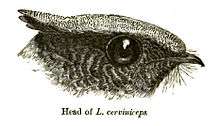Great eared nightjar
| Great eared nightjar | |
|---|---|
_(2).jpg) | |
| Scientific classification | |
| Kingdom: | Animalia |
| Phylum: | Chordata |
| Class: | Aves |
| Order: | Caprimulgiformes |
| Family: | Caprimulgidae |
| Genus: | Lyncornis |
| Species: | L. macrotis |
| Binomial name | |
| Lyncornis macrotis (Vigors, 1831) | |
| Synonyms | |
| |
 |
|
| Problems playing this file? See media help. | |
The great eared nightjar (Lyncornis macrotis) is a species of nightjar in the Caprimulgidae family. It is the largest species in the family in terms of length, which can range from 31 to 41 cm (12 to 16 in). Males weigh an average of 131 g (4.6 oz) and females weigh an average of 151 g (5.3 oz) so it the second heaviest species in the family after the nacunda nighthawk.[2]
Distribution and habitat

It is found in Southeast Asia with populations in the Western Ghats and Sri Lanka.[3] Indonesia, India, Laos, Malaysia, Myanmar, the Philippines, Thailand, and Vietnam. Its natural habitat is subtropical or tropical moist lowland forests.
Behaviour
Like other nightjars they are active at dusk and at night. They have a distinctive call which includes a sharp tsiik followed by a pause and a two-syllable ba-haaww.
Breeding
The nest is a scrape on the ground and the clutch consists of a single eggs. The chicks are well camouflaged among leaf litter.[4]
Taxonomy
Several populations are given subspecies status and include:
- the nominate form macrotis (Vigors, 1831) from the Philippines
- bourdilloni (Hume, 1875) of the Western Ghats
- cerviniceps (Gould, 1838) along the eastern Himalayas into Indochina and northern Malaysia
- jacobsoni (Junge, 1936) of Simeulue Island
- macropterus (Bonaparte, 1850) from the islands of Sulawesi, Talaud, Sangihe, Banggai and Sula
References
- ↑ BirdLife International (2009). "Eurostopodus macrotis". IUCN Red List of Threatened Species. Version 2008. International Union for Conservation of Nature. Retrieved 10 March 2010.
- ↑ CRC Handbook of Avian Body Masses, 2nd Edition by John B. Dunning Jr. (Editor). CRC Press (2008), ISBN 978-1-4200-6444-5.
- ↑ Soysa, W. C., A. A. T. Amarasinghe and D. M. S. S. Karunarathna (2007). A record of the Great Eared Nightjar Eurostopodus macrotis Vigors, 1830 (Aves: Caprimulgidae) from Sri Lanka. Siyoth, 2 (1): 88-90.
- ↑ Strijk JS (2004). "Description of the nest and nestling of Great Eared Nightjar Eurostopodus macrotis from Luzon, Philippines" (PDF). Forktail. 20: 128–129.
